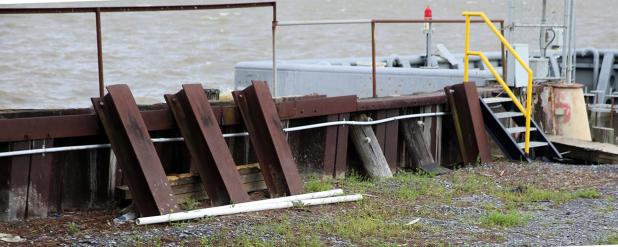
The flood protection system at Walnut Street at Lakeside Subdivision
From the Editor: On levees, the answer is there is no answer yet
Lee Dragna, who chairs the St. Mary Gravity Drainage District No. 2 board, has been sounding an alarm.
Dragna went to the St. Mary Parish Council meeting Jan. 21, hoping to get answers about the Morgan City levee improvements in which the district is taking part.
Those answers would have to come from the St. Mary Parish Levee District, which is working with the drainage district on the levees. Levee district board member Norris Crappell stepped up to the lectern at the council meeting and promised Dragna would get his answers.
But “I haven’t had any new updates to provide to him or the public,” levee district Director Tim Matte said in a phone interview Friday.
The drainage district has been in charge of much of the work of improving the levees that protect Morgan City. The levee district is in charge of the portion along Lake Palourde Drive and in front of Lakeside Subdivision.
The drainage district has been working on its part of the work for three years. The levee district is studying exactly what needs to be done in the Lake Palourde Drive portion.
Because the improvements won’t be complete until the Palourde Drive work is done, Dragna has been warning that the project needs to be completed to head off drastic increases in flood insurance premiums.
“I’m at my wits’ end …,” Dragna told the Parish Council. “We do $22 million worth of work and we’ve got nothing.”
A look at what’s been happening in the National Flood Insurance Program justifies a certain level of concern.
The program makes it possible to obtain flood insurance in areas considered to be at high risk for flood losses. Basically, the government buys reinsurance in case the private sector company that provides your flood insurance gets socked with a lot of losses.
The trouble is that the program has been losing money for years, and political fights break out periodically over what to do about it.
You may remember that the National Flood Insurance Program was one of the problems the parties were fighting over during the 2010 government shutdown. More recently, and just before last Christmas, Congress kicked the can down the river with a nine-month extension of flood insurance funding and put off the tougher decisions until September.
On top of that, the Federal Emergency Management Agency is considering a new way of assessing flood risk called Risk Rating 2.0. Currently, the big factor in whether you have to buy flood insurance to get a mortgage is whether you live in the 100-year flood plain. Put another way, you’d have a 1% chance of flood damage each year.
Risk Rating 2.0 would “fundamentally change the way FEMA rates a property’s flood risk and prices insurance,” FEMA says on its website.
Risk Rating 2.0 “will incorporate a broader range of flood frequencies.”
Factors such as a home’s distance from the coast or other flooding sources, “different types of flood risk,” and the cost of rebuilding will go into figuring your insurance rates, FEMA said.
Lawmakers in states including Louisiana howled long and loudly enough that the implementation date for Risk Rating 2.0 was delayed a year until October 2021. The opponents say the new system would cause a big spike in insurance premiums in places like Louisiana, where 500,000 homeowners buy flood insurance.
(Politico noted that the original implementation date was just before the presidential election.)
So there is some urgency in demonstrating to the feds that the levees are in shape.
But along Lake Palourde Drive, Matte said, one thing is lacking.
The levee district is looking at five alternatives. The most extensive is building a berm and a breakwater at a cost of $30 million.
“Neither the drainage district nor the levee district have the availability of funds to do that,” Matte said.
Some people in Lakeside, where Lake Palourde access is desired, have asked about having flood protection built in front of their homes rather than on the lake side.
“When you apply to individual property owners, they say, ‘Hey, what are you going to do to my house?’ We’re not at that level.”
No matter what happens or how, the district will need rights of way to do the work.
“We need a consensus,” Matte said.
Bill Decker is managing editor of The Daily Review.
